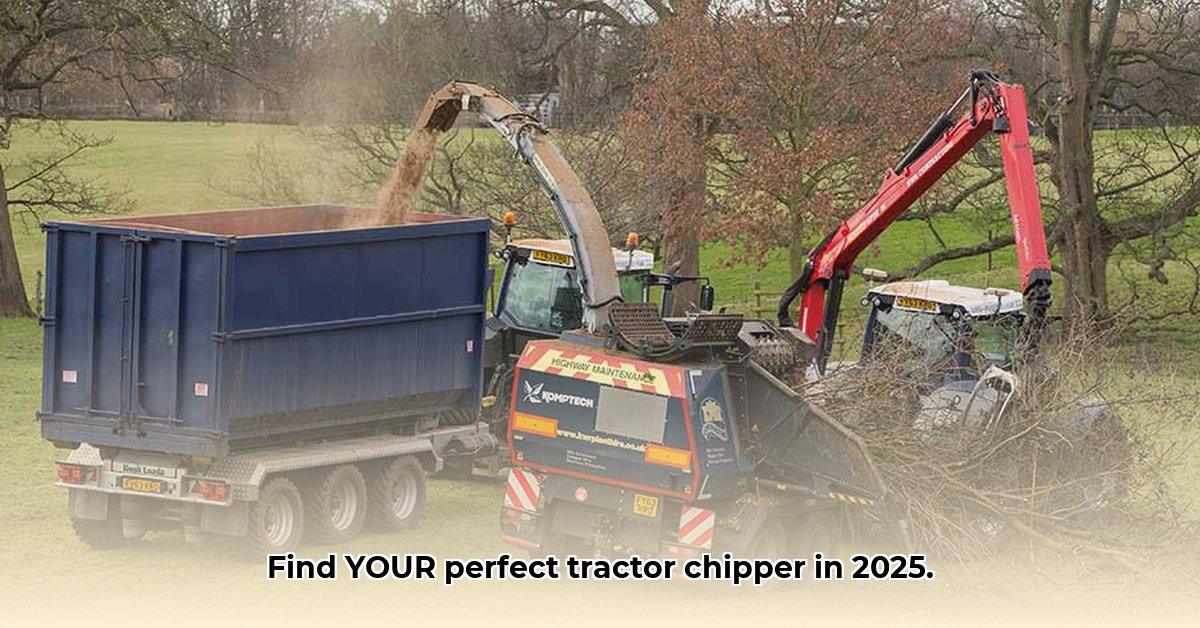
Picking the right tractor-mounted chipper can be daunting. This comprehensive buyer's guide navigates you through the process, helping you choose a machine that's efficient, safe, and perfectly suited to your needs. We’ll cover key features, compare models (where possible), and highlight crucial factors for long-term value. For even more detailed information, check out this helpful resource.
Understanding Key Features and Specifications
Several key specifications dictate a chipper's performance and suitability. Let's explore these crucial factors.
Engine Power and Chipping Capacity
Engine horsepower (HP) directly impacts a chipper's ability to process material. Higher HP generally translates to greater chipping capacity, often measured in cubic feet per hour (CFH). But do you really need the most powerful engine? A smaller, more fuel-efficient model might suffice for smaller-scale operations, saving you money on fuel and maintenance. Consider your typical workload before opting for maximum HP. Will your projects regularly demand the highest processing speeds, or will a more modest engine suffice?
Infeed System: Hydrostatic vs. Hydraulic
The infeed system moves material into the chipper. Two prominent designs exist: hydrostatic and hydraulic. Hydrostatic systems often boast reduced heat generation and potentially lower oil consumption, leading to increased efficiency. Hydraulic systems, on the other hand, are known for their robust power and reliability, making them a popular choice for demanding applications. The optimal choice depends on your priorities: efficiency versus proven reliability. Independent testing is needed to provide definitive comparisons. Do you prioritize maximizing efficiency, or do you value the reliability of established technology?
Rotor Design and Material Handling
The rotor is the heart of the chipper. While specific rotor types (like impeller or hammermill) may not always be explicitly stated by manufacturers, the type of material you plan to chip is vital. Hardwoods and thick branches require a more robust rotor than smaller, softer materials. An ill-suited rotor can result in jams, reduced efficiency, and potential damage. Does your workload primarily involve softwoods and smaller branches, or will you frequently work with denser hardwoods and thicker branches?
Safety Features: Prioritizing Protection
Safety is paramount. Essential safety features include emergency shut-offs, clearly defined safety guards, and easily understandable operating instructions. Never compromise on safety. What safety features are essential for your working environment and skill level?
Comparing Models: WoodMaxx, Land Pride, and Others
Direct comparison between brands like WoodMaxx and Land Pride presents challenges. Comprehensive, independent testing data is limited. Manufacturer specifications provide initial information, but they are often geared towards marketing. Therefore, truly objective comparisons remain difficult. We must rely on the available information and acknowledge the need for further independent testing. This section uses available data from manufacturer specifications, but treat them as preliminary information until independent testing provides a more complete picture.
| Feature | WoodMaxx (Example) | Land Pride (Example) | Considerations |
|---|---|---|---|
| Engine HP | Varies by model | Varies by model | Match HP to your workload. |
| Chipping Capacity | Varies by model | Varies by model | Assess your average hourly chipping volume. |
| Infeed System | Hydrostatic or Hydraulic | Typically Hydraulic | Prioritize efficiency or proven reliability. |
| Warranty | Check manufacturer's website for details | Check manufacturer's website for details | Warranty length significantly affects long-term costs. |
| Price | Varies by model | Varies by model | Factor in maintenance and total cost of ownership. |
Tractor Compatibility: A Crucial Consideration
Ignoring tractor compatibility can lead to costly damage. Before purchasing a chipper, verify compatibility with your tractor's specifications. This includes PTO (power take-off) horsepower, hitch type, and hydraulic system flow rate. A mismatch can severely impact performance and may even damage your tractor or chipper.
Maintenance, Costs, and Total Cost of Ownership (TCO)
Regular maintenance extends the lifespan of your chipper. This includes blade sharpening, lubrication, and addressing any issues promptly. The availability and cost of replacement parts significantly influence the total cost of ownership (TCO). A longer warranty provides financial peace of mind and reduces long-term costs. How will component availability and cost influence your decision?
Safety: A Top Priority
Always prioritize safety. Follow the manufacturer's safety guidelines, adhere to relevant OSHA standards, and utilize appropriate personal protective equipment (PPE). Regular equipment inspections help prevent accidents and costly downtime.
Actionable Steps for Choosing Your Chipper
- Assess your needs: Honestly evaluate your chipping volume, materials, and budget.
- Research models: Explore different models and read reviews.
- Verify tractor compatibility: Confirm compatibility with your tractor.
- Compare prices and warranties: Consider the long-term implications of cost and warranty length.
- Seek independent reviews: Find unbiased opinions for a more holistic understanding of different models.
Conclusion: Making an Informed Decision
Choosing a tractor-mounted chipper requires careful consideration. Using this guide's information and prioritizing factors like safety, and total cost of ownership will significantly enhance your decision-making process. The absence of widespread independent testing highlights the need for thorough research and careful evaluation before committing to a purchase.